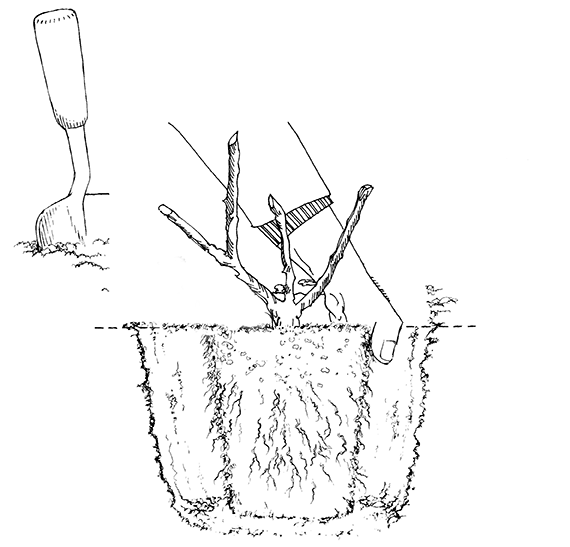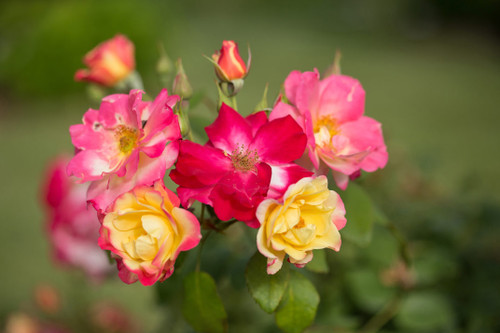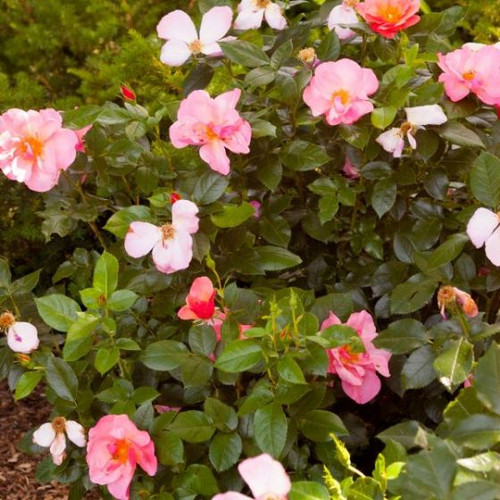Product Overview
Like two Roses rolled into one, this marvel opens sorbet yellow then blushes pink with single to semi-double flowers exhibiting both colors simultaneously through summer to autumn. Thanks to steadfast disease resistance and mounded form, the unique display is continually tidy. Own-root. 'Radpastel' PP 26,675
Roses offer colors, perfumes, forms, and habits to suit every garden situation. The tenacious efforts of breeders have yielded Roses with the best attributes of different varieties in new forms. Hybrid Teas, lovely as ever, now combine long bloom periods with the vigor to shrug off pests. Shrub Roses bloom for months, rather than weeks, in addition to their ever-appealing hardiness and longevity. A new group is so exceptionally long-blooming and carefree that they are simply called "Landscape Roses." In short, these are not your grandmother’s, or even your mother’s, finicky Roses. Simply choose according to your circumstances. Roses require 6 or more hours of direct sun per day and a fertile, reasonably moist soil.
Planting Potted Roses:
- Check the moisture of the potting mix in the container and, if dry, water thoroughly.
- Dig a hole wide enough and just deep enough for the root ball.
- Add organic matter—such as compost or aged manure—and mix this into the soil dug from the hole.
- Remove the plant from the container and gently break up the sides of the root ball with your thumbs and carefully untangle any roots circling at the bottom.
- Set the root ball in the hole so that the top of the root ball is level with the surface of the surrounding soil.

- Push the mix of soil and organic matter back into the hole, tamping firmly as you go. Water thoroughly.
- Add a generous layer of organic mulch (compost or aged manure is best) to help keep the soil evenly moist.
- Water thoroughly once a week if rainfall is scarce during the growing season and throughout fall.
Light: Roses grow best where they receive at least 6 hours of direct sun per day.
Watering: We recommend watering in the morning if possible so that the foliage doesn’t remain wet into the evening. If the weather is dry, water thoroughly every 2 weeks.
Fertilizer: Roses grow more vigorously, bloom more prolifically, and show greater resistance to diseases if fertilized during the growing season.
- For best results, add a layer of compost or aged manure in early spring around the base of the plant. After the first wave of bloom, apply a bloom-boosting fertilizer (15-30-15).
- For organic gardeners, we recommend adding a layer of compost or aged manure in early spring and applying an organic fertilizer after the first wave of bloom.
Pests & Diseases: The Roses we offer are selected for their vigor and their resistance to pests and diseases.
- Some Roses are prone to fungus problems (such as black spot) in hot, humid areas. Cleaning up old foliage from the base of the plant is important for disease control.
- We recommend the use of environmentally-friendly horticultural oil and insect sprays listed by the Organic Materials Review Institute (OMRI).
- Japanese beetles may be handpicked or a systemic pesticide may be used. In spring, check for Rose slugs (sawfly larvae that appear as tiny, green caterpillars and skeletonize Rose foliage) and physically destroy them or spray with superfine horticultural oil.
Pruning: Prune Roses to remove deadwood, to control or direct growth, and to promote flowering.
- Wait until growth breaks from the canes in early to mid-spring before pruning.
- To train climbers in early spring, trim thinner side shoots from the base of the main branches. Attach new stems to their supports throughout the growing season.
- If the Rose bush has become too tall, the stems may be cut back by one-third to one-half in early spring or after the first wave of blooms.
- With the exception of the rugosas, which produce attractive hips (fruits), remove the spent flowers of reblooming Roses to promote more bloom.
Transplanting: Roses may be moved in early spring when dormant.
End-of-Season Care: In our experience, the best way to get Roses through winter is to choose plants adapted to your climate zone.
- Mound 2 shovelfuls of bark mulch around the base of the plant before the start of winter. This added layer of protection is especially important for grafted Roses.







